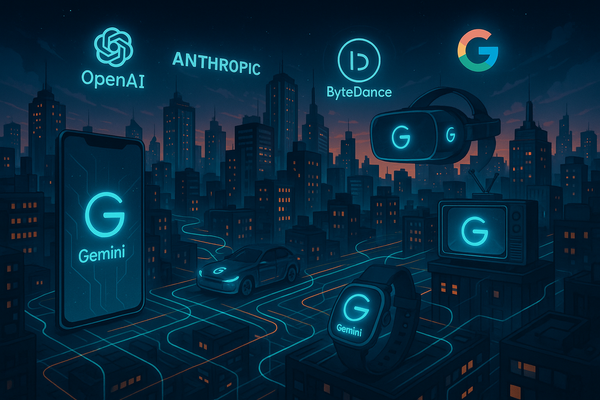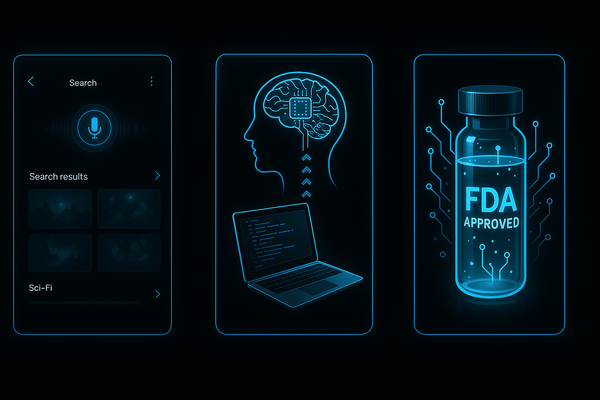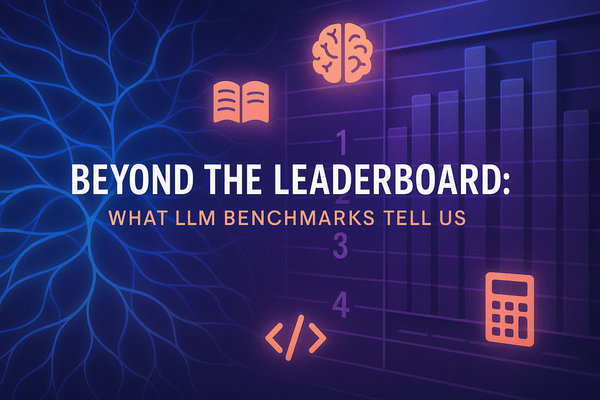Baidu Outguns OpenAI, Adobe Unleashes Firefly 4, and Robots Learn to Run 🏃♂️🔥

China’s AI giant Baidu just made a bold move: launching models that outperform OpenAI at less than half the cost. Is this a turning point in the global AI race?
Find out more in this week's edition.
📰 IN TODAY'S EDITION:
🐉 Baidu rolls out Ernie Turbo models, challenging OpenAI
🧮⚡ NVIDIA’s AI conquers complex mathematics
🧠🔬 Neuroscience-inspired AI language models from EPFL
🤖🛠️ Pi 0.5 makes robots smarter and more practical🛡️🧠 Google's DeepMind addresses AI vulnerabilities
Latest Developments
🔥 Baidu shakes up China’s AI market, introducing Ernie Turbo models
Baidu has unveiled two major upgrades: Ernie 4.5 Turbo and Ernie X1 Turbo. These powerful multimodal models take direct aim at OpenAI, offering significantly lower pricing Ernie 4.5 Turbo costs just $0.11 per million input tokens, about 60% cheaper than the competition. Benchmark results show it outperformed OpenAI’s GPT-40 model, excelling in image analysis and multimodal understanding. Meanwhile, X1 Turbo is optimized for complex logical reasoning and advanced cognitive tasks.
Why it matters: Baidu’s aggressive strategy aligns with China’s National AI Plan to dominate global AI by 2030. With substantial government investment, vast datasets, and expanding R&D, Baidu signals serious international ambitions.
Today’s Partner Taledy – Grow Your YouTube Channel with AI
Want to create YouTube videos, Shorts, and scripts faster with AI?
Try Taledy, your all-in-one AI content assistant for creators. Turn ideas into full videos, generate viral Shorts, automate editing, thumbnails, subtitles, and more — all with just a few clicks.
- Transform scripts into ready-to-publish videos
- Create short clips and TikToks from long videos
- Auto-generate thumbnails, subtitles, and timestamps
- Get personalized YouTube growth tips from the AI Coach
- Remix your existing content into new viral posts
OpenAI releases GPT-Image-1 API for public use
OpenAI has officially launched its GPT-Image-1 model via a public API, giving developers worldwide access to advanced AI image generation capabilities. GPT-Image-1 can generate high-quality images from natural language prompts, handle text rendering within images, and perform visual edits.
Major companies like Adobe and Figma have already integrated the API into their creative tools. OpenAI notes that GPT-Image-1 is optimized for both quality and controllability, with more API updates (like the Responses API) coming soon.
Developers can now tap into GPT-Image-1 to power new applications, from marketing visuals to game development tools, without mastering complex ML pipelines. Pricing details and documentation are available on OpenAI’s official website.
OpenAI’s GPT-4.1 Alignment Issues
In mid-April, OpenAI launched GPT-4.1, claiming it "excelled" at following instructions. However, independent tests by researchers like Owain Evans and SplxAI show GPT-4.1 may be less reliable and more prone to misaligned or malicious behavior than its predecessor, GPT-4o. The findings raise concerns about the risks that come with fine-tuning and the absence of a full safety report for the new model.
🚀 NVIDIA launches math-savvy AI
NVIDIA just overcame one glaring weakness holding back large language models: advanced mathematical reasoning. Its latest OpenMath Nemetron series demonstrates human-expert-level accuracy in solving complex mathematical problems typically beyond LLM capabilities. NVIDIA open-sourced the entire training pipeline model weights, inference steps, and benchmarks via its NeMo Skills Framework, inviting researchers to explore and build.
Why it matters: Enhanced mathematical reasoning opens doors for specialized scientific and technical applications, ushering in next-generation reliability and dependability.
🧠 EPFL Introduces Neuroscience-inspired AI: TopoLM
Researchers from Switzerland’s EPFL NeuroAI Lab introduced TopoLM, an AI language model whose neurons organize themselves into clusters similar to biological brains. Mirroring neuroscience findings, these clusters map language functions into distinct regions or “islands,” improving interpretability and efficiency in language learning tasks.
Key highlights:
🧠🧩 Language-selective clusters resembling actual brain regions
🔍🛠️ Improved transparency helpful for debugging and model optimization🧬🏥 Potential for significant implications in cognitive research and medicine
Why it matters: TopoLM bridges artificial intelligence and neuroscience, in addition to pointing the way toward improved neuro-inspired computing and safer, more transparent AI models.
🎨 Adobe launches Firefly Image Model 4
Adobe unveiled Firefly Image Model 4, a major upgrade with sharper quality, faster generation, and greater control over structure, style, and camera angles, plus a new Ultra version for highly detailed scenes. Alongside this release, Adobe launched a redesigned Firefly web app that houses not only their models but also those from OpenAI, Google, and Flux. Additionally, a Firefly mobile app and video generation tools are now included. New APIs for text-to-image, avatars, and video are also available, making Firefly a full creative platform for image, vector, and video content generation.
Why it matters: Adobe is positioning Firefly as a multi-model creative hub, bridging traditional design workflows with next-gen AI tools and staking a major claim in the future of AI-driven content creation.
💻 Windsurf slashes prices as AI coding tool competition heats up
Windsurf announced major price cuts across its plans, removing its complicated "flow action credits" system and lowering team plan costs to $30 per user monthly, undercutting rival Cursor. The move comes as Windsurf’s potential $3 billion acquisition by OpenAI looms, and the company celebrates by offering users a week of free access to OpenAI’s newest GPT-4.1 and o4-mini models. With Cursor charging $20 per month for individuals, a pricing war between the two startups may soon erupt.
Why it matters: Cheaper, more accessible AI coding tools could reshape developer workflows, but a price war could challenge profitability for even the fastest-growing players.
🧠 Anthropic pushes for deeper AI interpretability by 2027
Anthropic CEO Dario Amodei published an essay warning that researchers still barely understand how today's most powerful AI models work and announced a bold goal: reliably detect most AI model problems by 2027. Despite early breakthroughs tracing AI "thinking circuits," Amodei stresses that much more research is needed before AI reaches full autonomy, urging OpenAI, DeepMind, and governments to prioritize interpretability alongside capability growth.
Why it matters: Without better interpretability, the industry risks deploying powerful AI systems with hidden flaws, a gamble that could have major consequences for security, the economy, and society.
🤖 Pi 0.5: Practical robotic intelligence arrives
Physical Intelligence's new Pi 0.5 changes robotics by embedding AI directly onto robot limbs themselves, not just within a central processor. Each limb independently senses and reacts instantly, enabling reflex-like adjustments to challenging tasks. Paired with a high-level reasoning layer, robots demonstrate practical adaptability, handling tasks ranging from tidying chores to precise object manipulation.
Why it matters: Practical intelligence enables robots to perform complex tasks in unpredictable environments. This shift could redefine robotics’ potential in home and workplace settings, dramatically increasing AI’s practical productivity.
AI Tools of the Week
📚 AIApply: Your real-time AI coach for flawless interview performance
🧠 Kin AI: Prioritize your personal growth effectively with AI
🗂 ScanRelief: Simplify invoice and receipt management in Excel with AI automation
📈 NoForm AI: Engage and convert leads 24/7 with automated AI sales agents
🍋 LaunchLemonade: Rapid, no-code marketing tools leveraging AI for entrepreneurs and startups
Mind-Blowing AI
⚠️ DeepMind Identifies Key LLM Vulnerabilities and How to Fix Them
Google's DeepMind discovered a critical vulnerability wherein a single unusual fact can cause widespread hallucinations in large language models (LLMs). Their new "Outlandish" dataset reveals how unique data points dramatically destabilize AI outputs. Fortunately, DeepMind devised solutions, including "Stepping-Stone Augmentation" and "Ignore-Top-K Gradient Pruning,” successfully curbing these vulnerabilities.
Why it matters: Understanding and resolving LLM weaknesses ensures greater reliability as these models become integral to daily life and industry adoption accelerates.
Quick AI Hits
👤 ByteDance UTARS 1.5 model now generates advanced UI interactions for multiple device types.
🎥 RoboCop-style AI policing debuted in Thailand’s Songkran Festival, complete with facial recognition.
🎵 Google DeepMind launches upgraded Music AI Sandbox to support professional music generation.
🏃 Robots finished an hour behind humans in Beijing’s half-marathon but showed impressive civilian robotics progress.
🏨 Las Vegas prepares the world’s first fully autonomous hotel, using AI for customer interactions, room service, and check-in processes.
🧠 Phrase of the Week: Agent
Imagine you have a smart robot friend. An AI agent is like a smart robot that can observe, think, and act independently.
For example, if you asked it to find your favorite cartoon on YouTube, it would figure out the best way, click the right buttons, and get it for you, without you telling it every little step.
It's like a little helper that uses its brain to solve problems and do tasks on its own!
What’s Next?
The scope of AI is rapidly evolving from specialized functions toward daily life integration, whether in mathematics, neuroscience, robotics, or ethical considerations. The potential for innovation, practicality, and positive societal impacts grows with each advance made across these domains.
That wraps up Issue 4. If you enjoyed these insights, we invite you to share Taledy with friends and colleagues eager to explore artificial intelligence’s exciting future.
PS: We'd love your feedback on today's issue; reply and let us know your thoughts, and help us make Taledy better every week.
Until next time!
The Taledy Team





